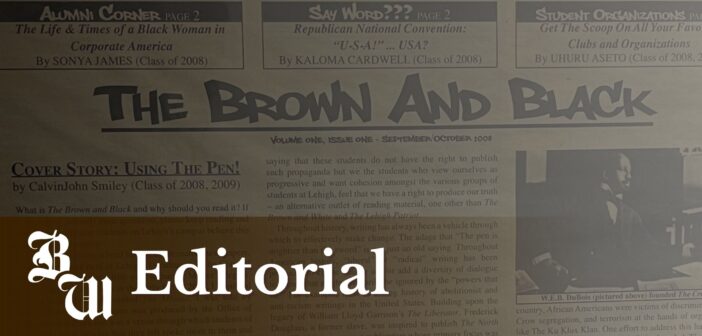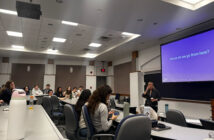The Brown and White is Lehigh’s oldest student publication, having started in 1894. But, despite its longevity, it hasn’t been the only one on campus.
Hidden in the halls of Christmas-Saucon is a forgotten front page. It sits in a modest black frame and is headed by a graffiti-style font. It’s the first issue of The Brown and Black.
In 2008, a group of students, including Calvin John Smiley, ‘08, ‘09G; Sonya James, ‘08; Kaloma Cardwell, ‘06; and Hector Velez, ‘11; none of whom were journalism majors, established a newspaper called The Brown and Black. Their goal was to voice a community underrepresented by existing campus media to candidly address race-related matters.
Smiley believed diverse voices were essential when reflecting on pressing issues. In the first issue of The Brown and Black, Smiley wrote, “Throughout history, writing has always been a vehicle through which to effectively make change. The adage that ‘the pen is mightier than the sword’ is not just an old saying.”
Prior to the launch of The Brown and Black, previous cohorts embarked on similar ventures. The Mosaic and The Inciter were two short-lived publications, both centered around the Black experience for Lehigh students.
The latter printed two issues before dying out. The former printed only one.
Today, existing copies of The Brown and Black are hard to find. But upon this discovery, our newsroom has taken time to sit and appreciate the work of students from over a decade ago. Smiley wrote specifically that he wanted to be an alternative to The Brown and White and the more politicized Lehigh Patriot.
Was The Brown and White really not for everyone?
Our staff prides itself on equitable coverage of the Lehigh and South Side communities. But how truly possible is that when our newsroom is overwhelmingly white?
If journalism’s purpose is to serve the public and report on truth, we should strive for equal opportunity in the newsroom so that our experiences can inform our work in the most productive way possible.
According to the Pew Research Center, fewer than half of journalists say their organization makes issues of diversity and inclusion a major priority, while only half have participated in a formal training session about diversity in their workplace in the past year.
The coverage produced by a workspace of any newsroom is influenced by individual and collective views, values and ideals. Acknowledging the intersection of those differences is the first step in creating a healthy environment.
This fall, The Brown and White was led by Nahjiah Miller, ‘24, to complete an exercise by Trusting News Media that looks to “help journalists more clearly articulate and acknowledge both our individual and our shared values.”
Miller shared during this workshop that despite being an invaluable member of the newsroom, she had not always felt comfortable in our space.
“The newsroom always felt distant, like there were barriers. I never felt there was room for me,” Miller said. “I wanted people in the newsroom to discuss or at least think about ways we can make it feel less like a harsh environment.”
Diversity, equity and inclusion (most commonly denoted as DEI) is a buzzphrase consuming companies, universities, and institutions. But talk is just talk. We want to do something that will better ourselves and the journalism community.
In our current newsroom, there are only two Black editors.
Our beginning steps represent modest but positive strides in the right direction. Regrettably, there may not be a favorable resolution to this current need for diversity, because Lehigh’s demographic makeup is consistently predominantly white. But that doesn’t mean we can’t be aware of our institution’s shortcomings and attempt to rectify them within our own space.
The details of how we are to do this is something we intend to continue discussing together and with allied stakeholders — consisting of groups both on and off campus, in and out of the journalism community — and put action to our discourse. But we hope promoting more open conversation is a solid first step.
Our meditation on this publication, The Brown and Black, is not to discourage our efforts, but to instead motivate us to keep the ball rolling.






Comment policy
Comments posted to The Brown and White website are reviewed by a moderator before being approved. Incendiary speech or harassing language, including comments targeted at individuals, may be deemed unacceptable and not published. Spam and other soliciting will also be declined.
The Brown and White also reserves the right to not publish entirely anonymous comments.
1 Comment
There might be few reporters of color on The Brown and White (B&W) but there seems to be reportage on more topics/ activities than that fact would seem to predict. Unfortunately Diversity seems not to be a factor in conservative topics/viewpoints.
The faculty seems to be over 75% liberal leaning and who knows the student body percentage? That might be a good B&W project.
Liberal views and neutral stories are covered by the B&W; conservative views are mentioned. Are there are no conservative stories to be told?